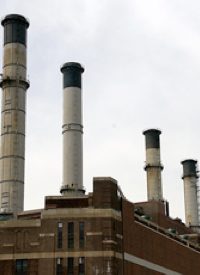
Due to new federal air pollution regulations, more than 32 power plants across the country will be forced to close their doors, according to a recent Associated Press survey. Those plants, which are mostly coal-fired, discharge enough electricity to supply more than 22 million households, the survey notes, and their closure will lead to job layoffs, depleted tax revenues, and a considerable hike in electric bills. The areas that will be hit hardest are the Midwest and in the coal belt (Virginia, West Virginia, and Kentucky), where dozens of plants will likely be retired.
Two regulations are in question: One aims to curb air pollution in states downwind from pollutant-heavy power plants; and the second, which was finalized last week, would enact the first standards for mercury, acid gas, and other pollutants from plant smokestacks. In total, the new regulations could eliminate more than eight percent of coal-fired generation nationwide.
AP’s survey, the first of its kind, looked at the analyses by the Environmental Protection Agency (EPA) of plant retirements and interviewed 55 power plant operators about the effects on power supply and about their plans to deal with the new regulations.
Basing their assertions on energy analyses, congressional reports, and government regulators, critics have predicted that the new EPA regulations will lead to widespread blackouts, and possibly the retirement of coal as a power source altogether. However, proponents of the rules claim that those studies inflate closure numbers by considering plants shutting down for reasons other than the EPA’s new restrictions.
Opponents of the regulations have voiced their concerns. Rep. Darrell Issa (R-Calif.) asserted in a recent letter to the White House that the mercury rule could “unintentionally jeopardize the reliability of our electric grid.” At a recent speech in New Hampshire, former Utah Governor and GOP presidential candidate Jon Huntsman warned of summer blackouts. And a U.S. Chamber of Commerce advertisement warned that the regulations “could threaten America’s energy supply.”
For some plant owners, the EPA rules will dissolve facilities that are likely to fail anyway, but for others, the rules will mean retirements for generators already planning to comply with state laws and other EPA requirements. “The EPA regulation became a game changer and a deal changer for some of these units,” said Ryan Stensland, a spokesman for Alliant Energy, which has four plants that will be retired, and four more that are at risk of closing. “Absent the EPA regulations, I don’t think we would be seeing the transition that we are seeing today. It became a situation where EPA broke the back of coal.”
For some of the country’s oldest coal-fired plants, retirement is the most cost-effective alternative. “It is more expensive to retrofit these plants than retire them and build new generation,” asserted Chris Whelan, spokeswoman for Kentucky Utilities, which recently announced it will be closing three of its plants. Due to the closures, and the $800 million it’s spending to make its plants EPA-compliant, Kentucky Utilities expects its customers to see a 14-percent rate hike to deal with the additional costs and leaner supply.
Among some of the retired plants, Arizona’s largest utility will be deadbolting three of five generating units in 2013 at a facility in northwestern New Mexico, a decision the company largely attributes to the EPA’s mercury rule. The 2,040-megawatt Four Corners Power Plant is one of the largest in the United States, and it currently supplies electricity to about 300,000 households in Arizona, Texas, California, and New Mexico.
While some say the regulations are beneficial, and critical in order to address environmental concerns, others characterize them as inefficient and costly. Emerson Farley, who works at Four Corners Power Plant, said the union made up of trade groups from around the area has been battling to minimize the EPA’s mandates, and that statements about pollution adversely affecting public health are not the case with his plant’s workers, who work in close proximity to the emissions. “We have people working into their early 60s without any problems,” Farley attested. “We’re seeing quite a bit of retirees at that age leading the plant. Those are celebrations on our part.”
Government officials in Salem, Massachusetts, are now scrambling to identify new sources of revenue as the city’s coal- and oil-fired power station begins shutting its doors, which will weed out Salem’s largest taxpayer. While tourism remains the economic engine in the city, notorious for the 1692 witch trials, the retirement of the Salem Harbor Station will devastate city revenues. Because of the station’s closing, Salem will have to forfeit $4.75 million of its $70 million in annual tax revenues.
Salem Mayor Kimberley Driscoll said finding new revenue sources without giving in to a substantial boost in property and business taxes will far surpass any other challenge she has faced in her six years in office. “When you take a large chunk of tax revenues like that out of the revenue stream coming into the city, it has an impact if we have to make it up on the backs of other taxpayers,” she lamented. “And 85 percent of our taxpayers are residents, so you are talking mostly residential home owners who are feeling struggles and [are] strapped already in meeting their tax obligations.”
Many companies — most notably Southern Company, as well as American Electric, which has a slew of aging coal plants scattered throughout the Midwest — assured that they will be forced to retire facilities and terminate hundreds of jobs if they have to meet full EPA compliance by 2014. Officials from American Electric, which is based in Columbus, Ohio, said in June that the proposed rules would shut down parts of or all 11 of their plants, eliminating 600 jobs. The federal regulations would cost the company $8 billion, officials averred, mostly on retrofitting or shutting down plants which lack EPA-mandated equipment upgrades.
In response to an EPA analysis that he said was somewhat skewed, Scott Segal, who represents coal-fired plant operators, asserted, “For every one job that may be created in order to comply with the rule, we expect four higher-paying energy and manufacturing jobs to be lost.”



